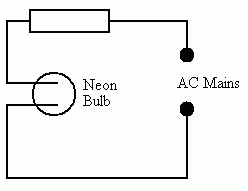
RANDOM PAGE
SITE SEARCH
LOG
IN
SIGN UP
HELP
To gain access to revision questions, please sign up and log in.
Non-Exam Extras
- Neon Bulbs are used as a mains-on indicator on older mains powered equipment.
- Neon is also used in illuminated signs used for advertising.
- LEDs are much easier to use, safer because they run on about 2 Volts and more energy efficient.

- The two neons on the left are running on a DC supply.
- The one on the right is running on AC.
- The negative probe lights up because this is the source of electrons and light is emitted when electrons re-combine with positive neon ions.
- With AC, each probe glows when it goes negative 50 (Europe) /60 (USA) times per second.
Neon Lamp Circuit

- Neon bulbs need about 60 volts to get the low pressure neon gas to conduct.
- Indicator light neon bulbs need a resistor to limit the current to a safe small value.
- When a high voltage (above 60 V) is applied across neon gas, electrons become detached from their parent neon atoms.
- When the electrons re-combine with a parent atom, red/orange light is emitted.
Big neon lights limit the current with an inductor instead of a resistor. The inductor limits the current with less energy lost as heat.
Other colour neon lights contain different gases or mixtures of gases to get the desired colour. These include argon, xenon and krypton.
reviseOmatic V3
Contacts, ©, Cookies, Data Protection and Disclaimers
Hosted at linode.com, London

